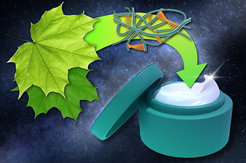Cosmetics made from plant-based raw materials?
Why lotions could become more sustainable in the future
Lotions and other cosmetics have a viscous consistency: sunscreen must adhere to the skin, a lotion must be absorbed quickly and a wound cream must remain on the wound long enough to release the active ingredients. To achieve this consistency, so-called "rheology modifiers" are added - chemical building blocks that adjust the flow properties of the cream. Modern rheology modifiers are highly efficient and typically based on fossil sources. In the "Kosmogel" project, a cooperation between the Max-Planck Institute for Polymer Research and Clariant, sustainable alternatives are now being investigated that can replace fossil raw materials in terms of effect. At the same time, their carbon footprint and biodegradability are to be improved.

Whether on the beach in the blazing sun, on a wound, on the face or on a baby's bottom: creams have many uses. Important with these: Depending on the application, it needs a certain consistency and texture to ensure optimal distribution and adhesion. This consistency is not created by chance in the production of creams, but rather by the targeted introduction of additives - so-called "rheology modifiers". These are long-chain molecules, that can combine with their neighbours at certain points to form a three-dimensional network, which leads to a modification of the flow properties of the cream. However, there is one major drawback: current rheology modifiers are based on fossil sources - that is, petroleum. Most synthetic rheology modifiers are therefore poorly biodegradable.
The project "Kosmogel" - a made-up word consisting of "kosmo" as in "cosmetic" and "gel" as in "gel" - which has now been launched, is a cooperation project between the Swiss company Clariant with research and development in Frankfurt am Main and the MPI-P institute. The aim: to create new, biodegradable and sustainable rheology modifiers that can be produced from natural sources. The important thing with these natural sources is that the production of the rheology modifiers does not compete with the use of this source for food, for example.
The envisaged technology of these novel rheology modifiers takes an example from nature, which already leads the way, for example, in the construction of tissue and combines smaller molecular building blocks into a large network. The newly initiated research project focuses on so-called "peptides" that can combine with their partners to form long fibres and networks and thus create structures similar to those of the cosmetic thickeners used so far. Unlike these, however, the connection is reversible, i.e. it can be undone again. This happens especially when they are exposed to the environment for a longer period - in addition to a plant-based solution, this one is also biodegradable.
The focus of the joint project is on researching the molecular properties of these peptides coupled with investigating their rheological properties. If the project is successful, novel rheology modifiers could be developed on this basis - not only for lotions and creams, but also for all kinds of other cosmetics.
The project will initially be funded by the BMBF for one year; an extension is possible depending on the results.












